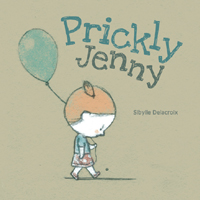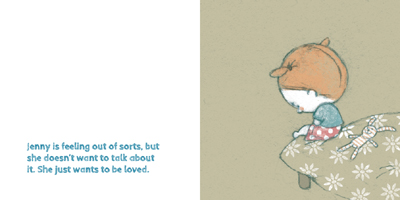| ________________
CM . . .
. Volume XXII Number 11. . . .November 13, 2015
excerpt:
Children and adults alike will relate to Prickly Jenny, by Sibylle Delacroix. Jenny is having a very grumbly day. She wakes up in the morning out of sorts, and the feeling follows her all day, from breakfast to the fair to nap time. She wants her old shirt, not her new dress. She doesn't want ice cream, but she eats it anyway. She wants her mom to leave her alone, but she cries when she leaves. If she smiles and anyone points it out, she will go back to being grumpy. Jenny is in a complicated mood that she doesn't want to talk about; she just wants to be loved. Jenny grumbles through the day to vent her frustrations, but, at the end of this story, she realizes that each day, as she gets older, things will get better. Prickly Jenny is a charming story of a young girl who is wrestling with conflicting emotions. Everyone has a day like this periodically, and Delacroix captures this experience beautifully. The overarching messages, that sometimes a person has a bad day and just needs some love, as well as that tomorrow will be a better day, shine through without being didactic. The language used in the story is at an appropriate level for the target audience, although adults may have to explain some of the terms used to describe Jenny's mood, terms such as 'grumbles', 'out of sorts', or 'fuss'.
Highly Recommended. Carla Epp is a hospital librarian with the University of Manitoba in Winnipeg, MB.
To comment
on this title or this review, send mail to cm@umanitoba.ca.
Copyright © the Manitoba Library Association. Reproduction for personal
use is permitted only if this copyright notice is maintained. Any
other reproduction is prohibited without permission.
Next Review | Table of Contents For This Issue - November 13, 2015 |

 The text and illustrations in this story play off each other. The left page of each layout is blue text on a white background while the right page of the layout is a complementary illustration. The illustrations in this story are a blend of digital and chalk pastel mediums. They are simple with fairly blank and muddy coloured backgrounds which make Jenny and whatever she is immediately focussed on jump off the page. For example, when Jenny is at the fair, the background is a green-brown color, and Jenny can be seen dragging her feet and her balloon as she trails behind her father's leg. Jenny's facial expressions throughout the story clearly portray how she is feeling. The illustrations are also humorous in places, such as when Jenny is tired and supposed to have a nap, but, instead, she is pictured doing a headstand in her bedroom. The text, itself, is, in some ways, part of the illustrations as well. The words in the story are printed in block letters, and each letter appears to be scribbled in with blue ink. It evokes the idea of a character with angry cartoon scribbles above his or her head to show frustration and plays well with Jenny's mood.
The text and illustrations in this story play off each other. The left page of each layout is blue text on a white background while the right page of the layout is a complementary illustration. The illustrations in this story are a blend of digital and chalk pastel mediums. They are simple with fairly blank and muddy coloured backgrounds which make Jenny and whatever she is immediately focussed on jump off the page. For example, when Jenny is at the fair, the background is a green-brown color, and Jenny can be seen dragging her feet and her balloon as she trails behind her father's leg. Jenny's facial expressions throughout the story clearly portray how she is feeling. The illustrations are also humorous in places, such as when Jenny is tired and supposed to have a nap, but, instead, she is pictured doing a headstand in her bedroom. The text, itself, is, in some ways, part of the illustrations as well. The words in the story are printed in block letters, and each letter appears to be scribbled in with blue ink. It evokes the idea of a character with angry cartoon scribbles above his or her head to show frustration and plays well with Jenny's mood.